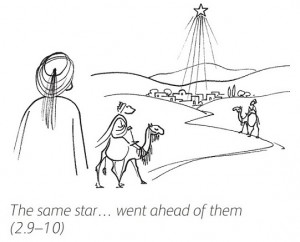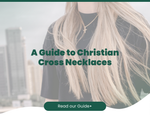What is the Good News Bible (GNB)?
Aaron Lewendon - Eden Bibles & Bible Study Specialist
Finding the right Bible isn’t easy. There are dozens of translations and hundreds of editions to choose from. Our new series of guides is here to answer your questions about the different Bibles on offer today.

The Good News Bible is a proclamation of sorts.
Its title echoes the heralding Angels of the nativity story. The ones in the Gospel of Luke who greeted a group of startled shepherds by saying “Don't be afraid! I am here with good news for you, which will bring great joy to all the people.” (Luke 2:10, GNB)
The Good News Bible (GNB) is a friendly and plain-language Bible whose goal was to speak to all people. To do this, it pioneered a new way of translating Biblical scriptures that incorporated the meaning of the text as well as the literal translation. Whilst not always with the exact same name or title, some edition of the Good News Bible has been in print since the 1960s. In fact, the Good News Bible has had four different names since its very first edition.
Adding to this, the Good News Bible was embraced across a large portion of Christianity and continues to be the Bible of choice for many Churches across the UK. And not only the UK, but across the world. Its elegant line drawings and immediately-graspable text have remained fixed in the hearts of Christians for decades.
The Good News Bible reminds readers that above everything else the word of God is, ultimately, good news for all people.
History of the Good News Bible
Every Bible translation arises from a need.
The King James Bible arose from the need for an English Bible amongst the general population of 17th century England. The NIV Bible was birthed from a need for a Bible that reflected the language of 1970s America. The Message followed that cause as modern English had moved on a lot since then.
The need for the Good News Bible came from somewhere further afield than most other Bible translations.
Requests from missionaries in Africa and Asia, as well as from new Christians whose first language wasn’t English, brought to light the need for a Bible that spoke a plainer language. A simpler language. If God’s word is for all people, then all people should be able to read it. This philosophy was, in part, what propelled the King James Bible into existence almost 400 years earlier. That there should be no barriers to the Bible for anyone.
At the very heart of the Good News Bible’s story is one man: Eugene Nida. A prominent linguist as well as a Baptist minister, Eugene Nida was a key figure in the field of Bible translation. He was a founding member of the Wycliffe Bible Translators, a linguist at the American Bible Society before rising to the level of Executive Secretary for Translations, and ordained as a Baptist minister in the same year he received his Ph.D. in Linguistics. The achievement that has outlasted all of these, though, is his development of a new way to translate the Bible: Dynamic Equivalence.
Dynamic Equivalence aimed to get to the thought behind the words of the original scriptures. Not just the direct translations of the language.
.png)
This new approach to translation has been embraced by a wide range of Bible translations since. These include the NLT, the Jerusalem Bible, the NIV Bible, the CSB, and dozens more. Dynamic Equivalence is how a huge number of Bibles are translated to this day, but was pioneered in the Good News Bible.
The Good News Bible didn’t always go by that name. In fact, it wasn’t even called a Bible. The very first edition of the Good News Bible bore the title ‘Good News for Modern Man’. It wasn't a full Bible, but rather a paperback New Testament. Before it went to print, a test of Dynamic Equivalence took place using the Gospel of Mark. After it was well-received, the Good News for Modern Man hit shelves in 1966.
Released with the even longer title of ‘Good News for Modern Man: The New Testament in Today's English Version’, this New Testament was a hit. You could find it in bookshops, Churches and on the shelves of supermarkets. Despite being a paperback with a hefty length of 599 pages, the Good News for Modern Man went on to be printed in four different editions. Each one came only a few years after each other.
During this time, the books of Psalms, Proverbs, Job, Ecclesiastes, Jonah, Ruth, Hosea, Amos, Micha and Exodus were also published.
For anyone who's counting, that leaves 29 books of the Bible left for translation. Combined with the New Testament edition, the task of creating the complete Good News Bible was already over halfway done.
Finally, in 1976, the Good News Bible was finished. Published as 'Good News Bible: The Bible in Today's English Version', the full-Bible edition would be known by many names: The Good News Bible, the Good News Translation, and Today’s English Version.
To this day, the Good News Bible, in all its names, is one of the bestselling Bible translations of all time. It showed to the world that the Bible didn’t have to be intimidating or difficult to read. The Bible could be a source of hope for all people, regardless of language or reading ability.

Throughout the Good News Bible's story, there was one other person whose contribution helped make the Good News Bible what it is: Annie Vallotton.
Born in Switzerland in 1915, Anne Marie Vallotton was a committed Christian and illustrator. She only ever published one work before the Good News Bible. That work, a collection of illustrations from the life of Jesus, was deemed so unmarketable that her French publisher was said to have dumped 3,000 copies of it in the Seine.
When her work came to the attention of Eugene Nida, the two of them arranged to meet. Ten minutes into that first meeting, Nida and Vallotton came to the agreement that she would provide illustrations for Good News For Modern Man.
Annie Vallotton’s signature style of line drawings was a perfect fit for the simple and clean text of the Good News Bible. Both the bible and its illustrations championed the simple and expressive truth of God’s word.
It was through illustrating the Good News Bible (whose sales quickly rocketed into the millions) that a humble Swiss-French illustrator became one of best-selling artists of all time.
How Was It Translated?
As mentioned, the Good News Bible was the pioneering example of Eugene Nida’s new method of translation. Also known as Functional Equivalence, Dynamic Equivalence sought to communicate the sense, or message, of a text. Readability was a key endpoint for texts translated in this way. In his own words, Nida described the essential feature of Dynamic Equivalence as:
“[The] quality of a translation in which the message of the original text has been so transported into the receptor language that the response of the receptor is essentially like that of the original receptors."
Put simply, if an original language speaker heard the original text and you heard the translation of that text, both of you would still come away with the same impression. The same response and the same understanding. For a text that stretches back thousands of years, this is a big accomplishment. The gap between what ancient Israelites understand and modern readers today understand is huge.
The goal of Dynamic Equivalence is to shrink that gap as much as possible.
To bring the ancient scriptures' core message to today's reader.
How Accurate is the Good News Bible?
As a Dynamic Equivalence pioneer, one question that was frequently asked of the Good News Bible was ‘how accurate is it?’.
Before answering, it helps to know a couple more key terms used when discussing how accurate a Bible is. On the occasion that someone discusses Bible Translation accuracy, they will most likely draw a line in the sand between Bibles which are “word-for-word” and Bibles which are “thought-for-thought”.
Word-for-word Bibles present as directly as possible the text in the original scriptures. As the scriptures come from a culture far removed from our own, their texts are harder to understand and so any direct translations themselves require of the reader a sharp eye and working knowledge of the context from which the Bible came.
Thought-for-thought Bibles operate under a different approach. They use a greater level of textual interpretation throughout their translation process. This includes taking in wider contexts and meanings as a guide to what the original text meant and how that text would appear in today’s language.
If word-for-word is akin to Google Translate, operating with as little human interpretation as possible, then thought-for-thought is like a poem translated from another language, where meaning and form carry greater emphasis.
But where does the Good News Bible sit on the spectrum?
All Dynamic Equivalence Bibles are thought-for-thought Bibles. Dynamic Equivalence is simply the more technical term for thought-for-thought.
This means that the Good News Bible is firmly and proudly a thought-for-thought Bible. Its goal is to always communicate what is meant by the Bible text in a way that readers today can immediately grasp.
How Easy is the Good News Bible to Read?
The Good News Bible is written at about a 3rd Grade Reading Level. This means readers from the ages of 8 or 9 should be able to confidently read the majority of the Good News text and understand what it means.
What determines this level is the total number of unique words, as well as sentence length and the length of the words themselves. Other grammatical features also carry weight in the score. The greater the complexity, the higher the score. The reading level doesn’t take into account any understanding of a text's history and context. Only the words and grammar.
As an example, this sentence you are currently reading would score at a Grade Nine on the readability test.
This sentence would be at Grade Two.
Common Uses
Because of how easy it is to read, there is a Good News Bible available for readers of almost any age or background. As well as heightened ease for the reader, the Good News Bible isn't tied to any particular denomination or readership. It was endorsed by the late Billy Graham and prominently featured in his Crusades. The Good News Bible was also endorsed by the Catholic Church, the Southern Baptist Convention in America, and the Presbyterian Church.
In the UK, the Good News Bible has been embraced by Schools, owing to its simplicity and clarity. It also helps that the line drawings by Anne Vallotton help capture children's attention.
Different Editions
It’s not only the name of the Good News Bible that has changed a lot. The text itself is available in a wide variety of editions and versions.
The first major change since the Good News Bible was first released in its full form in 1976 was the addition of the Deuterocanonical Books. Commonly called the Apocrypha, this collection of books was added to the Good News Bible in 1979. The Deuterocanonical edition held a particular appeal for members of the Catholic Church, meaning there has been a Catholic edition of the Good News Bible in circulation for over 40 years.
After this, the next change was a revision of the Good News Bible’s text to feature inclusive language. This means that where words in the original scriptures could mean either a specific gender or mixed groups of people, the translation would choose the side of wider relatability. Words like ‘people’ and ‘man’ can both be translations of the Greek word anthropoi (this is where we get words like Anthropology - the study of people). When faced with anthropoi, the Good News Bible would choose to say ‘people’ whenever possible.
Whilst not a revision or update to the Good News Bible, the Contemporary English Version (CEV) followed in the Good News Bible’s footsteps. It aimed to be an even easier Bible to read. The language would be simpler, the grammar clearer.
The most recent additions to the Good News Bible family are Dyslexia-friendly editions. These use a clearer text size, thicker paper and other printed features that aid dyslexic readers in reading the Bible for themselves. Currently, only a small number of books from the Bible are available in this new edition, but that number is growing.
Example Verses from the Good News Bible
For God loved the world so much that he gave his only Son, so that everyone who believes in him may not die but have eternal life. - John 3:16
I alone know the plans I have for you, plans to bring you prosperity and not disaster, plans to bring about the future you hope for. - Jeremiah 29:11
Instead, be kind and tender-hearted to one another, and forgive one another, as God has forgiven you through Christ. - Ephesians 4:32
Versions You Can Buy Today
One of the most popular editions of the Good News Bible, the Sunrise Bible can be thought of as the 'all-things-to-all people' edition. It’s ideal for all-age worship in church, for schools and for personal study. Combining a trustworthy translation with a clear, readable style, it also contains the iconic and well-loved line drawings by Annie Vallotton.
.jpg)
The Rainbow Good News Bible is ideal for use with children in primary schools and churches. It contains all the usual features of the Good News Bible as well as full-colour inserts, new introductions, 100 famous Bible stories, and a clear Bible overview.
Bible Society and Youth for Christ have teamed up to create a truly unique Good News Bible that meets the needs of young people today. This Youth edition features links to YouTube videos, wide margins for journaling and drawing, new introductions and articles about the text, and full-colour pages about key topics and issues.
Good News Dyslexia Friendly editions
Presenting books from the Bible in a dyslexia-friendly way, these editions feature increased line spacing, larger text size, and cream coloured paper with high opacity and matt finish. The dyslexia-friendly books available so far are:
The Catholic Good News Bible is ideal for use in church, school and personal study. Combining an authoritative translation, it includes the Deuterocanonical Books in Septuagint order as well as line drawings by Annie Vallotton.
Frequently Asked Questions:
Is the Good News Bible Catholic?
Whilst not inherently so, Catholic editions of the Good News Bible are available. These editions feature the Deuterocanonical (Apocryphal) Books.
Is the Good News Bible a translation or a paraphrase?
The Good News Bible is a translation. Even though it features contemporary language, the text still adheres to being a functional translation of the Bible. But on the scale of Bible translations, it does sit closer to being a paraphrase than many other Bibles.
Other Bible Translations
Click on any of the images below to learn all about the stories behind some of the world's most widely-read Bible translations.






.jpg)
Latest Blogs

Gifts
Finding Your Symbol of Faith: A Guide to Christian Cross Necklaces
Looking for the perfect symbol of faith? Explore our guide to Christian cross necklaces, from rustic wooden designs and sturdy men's chains to elegant silver pendants.

Gifts
The Best Christian Gifts for Under £20
Looking for a meaningful gift that won't break the bank? Explore our guide to the best Christian gifts under £20, from inspiring journals to beautiful home decor.

Gift Guide
15 Confirmation Gift Ideas for Boys and Girls
Celebrating a confirmation? Discover 15 meaningful gift ideas for boys and girls, from youth Bibles and jewellery to inspiring journals and keepsakes.

Bible
30+ Powerful Quotes About the Bible (For Inspiration in 2026)
Looking for inspiration? Discover a curated collection of the most powerful quotes about the Bible, from famous historical figures to modern theologians and Scripture itself.

Bibles
What is the "Standard" Bible for Christians?
Is there an "official" Bible that all Christians use? We explain the difference between the NIV, KJV, and ESV, and help you find the standard text for your church or personal reading.

Bible
"I Keep Failing to Read the Bible" – 5 Tips to Make the Habit Stick
Do you start a Bible reading plan only to quit a few weeks later? Stop the cycle of guilt. Here are 5 psychological tips and practical changes to help you build a Bible habit that actually lasts in 2026.
